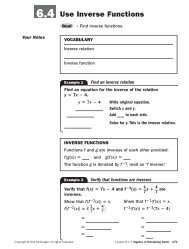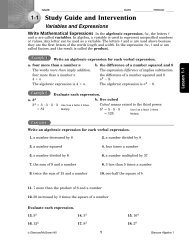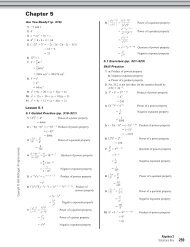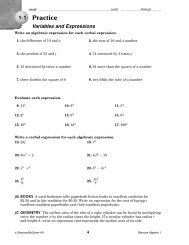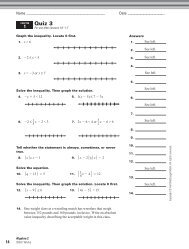real-world applications - MathnMind
real-world applications - MathnMind
real-world applications - MathnMind
You also want an ePaper? Increase the reach of your titles
YUMPU automatically turns print PDFs into web optimized ePapers that Google loves.
NAME _______________________________________________________ DATE _____________________________________<br />
REAL-WORLD APPLICATIONS<br />
STUDENT ACTIVITY for Transparency 3<br />
Use with Lesson 3-7.<br />
About Population Growth of U.S. Metropolitan Areas<br />
Census 2000 showed that the population in the United States increased by 13.2% from the<br />
1990 figures. This is the largest census-to-census increase in American history. Every state<br />
showed an increase in population, with Nevada showing the highest percent increase, 66.3%. In<br />
2000, metropolitan areas were home to about 80% of Americans, an increase of 14% from the<br />
last census.<br />
The graph shows both the population figures and the percent increase in population for the six<br />
largest metropolitan areas in the United States. Notice that some metropolitan areas extend<br />
across state lines while others fall within state boundaries.<br />
Directions: Use what you have seen and read to answer the following questions.<br />
1. In 1990, the population of the Los Angeles metropolitan area was almost 14.5 million people.<br />
What was the increase in population in the Los Angeles metropolitan area between 1990 and 2000?<br />
1.9 million people<br />
2. If the same rate of growth that occurred between 1990 and 2000 continues, what will be the<br />
population of the Washington-Baltimore area in 2010? 8,595,600 people<br />
3. How is it possible that the San Francisco and Philadelphia areas have about the same population, but<br />
have a different percent increase in population? The percent increase is the ratio of the<br />
increase in population to the original population figure. The ratios for San Francisco<br />
and Philadelphia may be different even though the new population figures are similar.<br />
4. The Dallas-Fort Worth area had an increase in population from 4.0 million to 5.2 million between<br />
the 1990 and the 2000 census. What percent increase in population did the area have?<br />
30% increase in population<br />
Making the Connection<br />
5. Look up the results of the 2000 census for the state and county where you live. Write a summary of<br />
the changes that occurred between the 1990 and 2000 census. What are some things that may be<br />
affected by the change in census figures for your state and county? See students’ work.<br />
© Glencoe/McGraw-Hill T3 Glencoe Algebra 1



